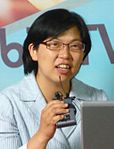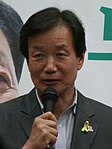2014 South Korean local elections
2014 South Korean local elections|
|
|
|
|
First party
|
Second party
|
Third party
|
|
|
 
|

|

|
| Leader
|
Kim Han-gil
Ahn Cheol-soo
|
Lee Wan-koo
|
Lee Jung-hee
|
| Party
|
NPAD
|
Saenuri
|
Unified Progressive
|
Regional
offices
|
5 governors
4 met. mayors
|
4 governors
4 met. mayors
|
0
|
Regional
offices +/–
|
 0 governors 0 governors
 2 met. mayors 2 met. mayors
|
 2 governors 2 governors
 1 met. mayor 1 met. mayor
|
 0 0
|
| Mayors
|
80
|
117
|
0
|
| Mayors +/–
|
 11 11
|
 35 35
|
 3 3
|
| Legislators
|
349 (P)
1,157 (M)
|
416 (P)
1,413 (M)
|
3 (P)
31 (M)
|
| Legislators +/–
|
 132 (P) 132 (P)
 12 (M) 12 (M)
|
 128 (P) 128 (P)
 149 (M) 149 (M)
|
 21 (P) 21 (P)
 84 (M) 84 (M)
|
|
|
|
Fourth party
|
Fifth party
|
|
|

|
|
| Leader
|
Lee Yong-gil
|
Cheon Ho-sun
|
| Party
|
Labor
|
Justice
|
Regional
offices
|
0
|
0
|
Regional
offices +/–
|
 0 0
|
New party
|
| Mayors
|
0
|
0
|
| Mayors +/–
|
 0 0
|
New party
|
| Legislators
|
1 (P)
6 (M)
|
0 (P)
11 (M)
|
| Legislators +/–
|
 2 (P) 2 (P)
 7 (M) 7 (M)
|
New party
|
|
 Gubernatorial & metropolitan mayoral elections: overall results and turnouts
Gubernatorial & metropolitan mayoral elections: overall results and turnouts  Gubernatorial & metropolitan mayoral elections: municipal-level breakdown
Gubernatorial & metropolitan mayoral elections: municipal-level breakdown |
The 6th local elections were held in South Korea on 4 June 2014.[1][2]
Provincial level elections
Metropolitan mayoral and gubernatorial elections
Metropolitan mayoral election winners
Gubernatorial election winners
Provincial legislative elections
| Division
|
|
|
|
|
Oth./Ind.
|
Total
|
| Seats |
Seats |
Seats |
Seats |
Seats
|
| Seoul
|
29 |
77 |
|
|
|
106
|
| Incheon
|
23 |
12 |
|
|
|
35
|
| Gyeonggi
|
50 |
77 |
|
|
|
128
|
| Gangwon
|
36 |
6 |
|
|
2 |
44
|
| Daejeon
|
6 |
16 |
|
|
|
22
|
| Sejong
|
5 |
9 |
|
|
1 |
15
|
| South Chungcheong
|
30 |
10 |
|
|
|
40
|
| North Chungcheong
|
68 |
10 |
|
|
|
81
|
| Gwangju
|
|
21 |
1 |
|
|
22
|
| South Jeolla
|
1 |
52 |
1 |
|
4 |
58
|
| North Jeolla
|
1 |
34 |
1 |
|
2 |
38
|
| Daegu
|
29 |
1 |
|
|
|
30
|
| Busan
|
45 |
2 |
|
|
|
47
|
| Ulsan
|
21 |
1 |
|
|
|
22
|
| South Gyeongsang
|
50 |
2 |
|
1 |
2 |
55
|
| North Gyeongsang
|
52 |
2 |
|
|
6 |
60
|
| Jeju
|
17 |
26 |
|
|
3 |
46
|
| Grand Total
|
463 |
358 |
3 |
1 |
20 |
849
|
Municipal level elections
Mayoral elections
| Division
|
|
|
Oth./Ind.
|
Total
|
| Seoul
|
5 |
20 |
|
25
|
| Incheon
|
6 |
3 |
1 |
10
|
| Gyeonggi
|
13 |
17 |
1 |
31
|
| Gangwon
|
15 |
1 |
2 |
18
|
| Daejeon
|
1 |
4 |
|
5
|
| South Chungcheong
|
9 |
5 |
1 |
15
|
| North Chungcheong
|
6 |
3 |
2 |
11
|
| Gwangju
|
|
5 |
|
5
|
| South Jeolla
|
|
14 |
8 |
22
|
| North Jeolla
|
|
7 |
7 |
14
|
| Daegu
|
8 |
|
|
8
|
| Busan
|
15 |
|
1 |
16
|
| Ulsan
|
5 |
|
|
5
|
| South Gyeongsang
|
14 |
1 |
3 |
18
|
| North Gyeongsang
|
20 |
|
3 |
23
|
| Grand Total
|
117 |
80 |
29 |
226
|
Municipal legislative elections
| Division
|
|
|
|
|
|
Oth./Ind.
|
Total
|
| Seats |
Seats |
Seats |
Seats |
Seats |
Seats
|
| Seoul
|
196 |
219 |
|
|
1 |
3 |
419
|
| Incheon
|
63 |
49 |
|
2 |
1 |
1 |
116
|
| Gyeonggi
|
214 |
207 |
1 |
2 |
|
7 |
431
|
| Gangwon
|
105 |
48 |
|
|
|
16 |
169
|
| Daejeon
|
30 |
33 |
|
|
|
|
63
|
| South Chungcheong
|
99 |
59 |
|
|
|
11 |
169
|
| North Chungcheong
|
79 |
41 |
1 |
|
|
9 |
130
|
| Gwangju
|
1 |
56 |
9 |
|
|
2 |
68
|
| South Jeolla
|
|
183 |
7 |
2 |
|
51 |
243
|
| North Jeolla
|
4 |
139 |
|
2 |
|
52 |
197
|
| Daegu
|
87 |
13 |
|
2 |
1 |
13 |
116
|
| Busan
|
108 |
66 |
1 |
|
|
7 |
182
|
| Ulsan
|
35 |
4 |
9 |
|
1 |
1 |
50
|
| South Gyeongsang
|
143 |
34 |
6 |
|
2 |
45 |
260
|
| North Gyeongsang
|
219 |
5 |
|
1 |
|
59 |
284
|
| Grand Total
|
1383 |
1156 |
34 |
11 |
6 |
277 |
2897
|
References
- ^ 정, 은균. "지방선거 사전투표, 나도 한번 해볼까?". Naver News (in Korean). Retrieved 2023-02-22.
- ^ Lee, Hongchun (2018), Kiyohara, Shoko; Maeshima, Kazuhiro; Owen, Diana (eds.), "A New Trend in Internet Election Campaigning: The Use of Smartphone Apps in the 2014 South Korean Local Elections", Internet Election Campaigns in the United States, Japan, South Korea, and Taiwan, Cham: Springer International Publishing, pp. 137–164, doi:10.1007/978-3-319-63682-5_6, ISBN 978-3-319-63682-5, retrieved 2023-02-22
External links






